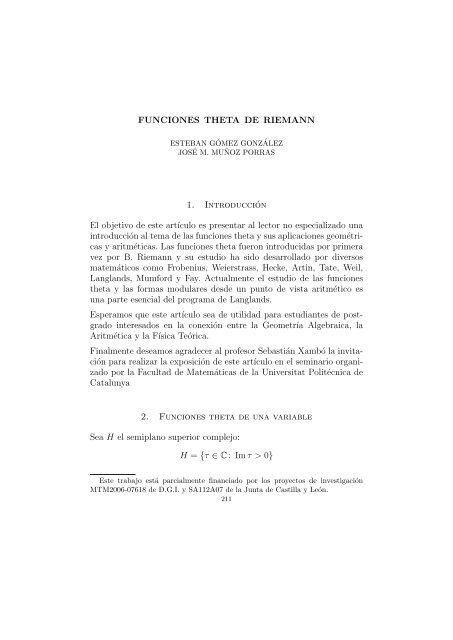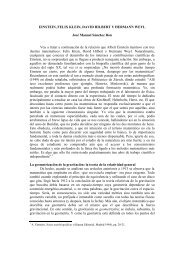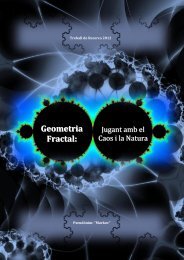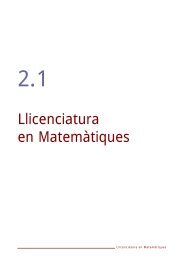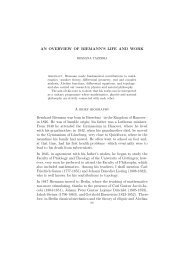FUNCIONES THETA DE RIEMANN 1. Introducción El objetivo de ...
FUNCIONES THETA DE RIEMANN 1. Introducción El objetivo de ...
FUNCIONES THETA DE RIEMANN 1. Introducción El objetivo de ...
Create successful ePaper yourself
Turn your PDF publications into a flip-book with our unique Google optimized e-Paper software.
<strong>FUNCIONES</strong> <strong>THETA</strong> <strong>DE</strong> <strong>RIEMANN</strong><br />
ESTEBAN GÓMEZ GONZÁLEZ<br />
JOSÉ M. MUÑOZ PORRAS<br />
<strong>1.</strong> <strong>Introducción</strong><br />
<strong>El</strong> <strong>objetivo</strong> <strong>de</strong> este artículo es presentar al lector no especializado una<br />
introducción al tema <strong>de</strong> las funciones theta y sus aplicaciones geométricas<br />
y aritméticas. Las funciones theta fueron introducidas por primera<br />
vez por B. Riemann y su estudio ha sido <strong>de</strong>sarrollado por diversos<br />
matemáticos como Frobenius, Weierstrass, Hecke, Artin, Tate, Weil,<br />
Langlands, Mumford y Fay. Actualmente el estudio <strong>de</strong> las funciones<br />
theta y las formas modulares <strong>de</strong>s<strong>de</strong> un punto <strong>de</strong> vista aritmético es<br />
una parte esencial <strong>de</strong>l programa <strong>de</strong> Langlands.<br />
Esperamos que este artículo sea <strong>de</strong> utilidad para estudiantes <strong>de</strong> postgrado<br />
interesados en la conexión entre la Geometría Algebraica, la<br />
Aritmética y la Física Teórica.<br />
Finalmente <strong>de</strong>seamos agra<strong>de</strong>cer al profesor Sebastián Xambó la invitación<br />
para realizar la exposición <strong>de</strong> este artículo en el seminario organizado<br />
por la Facultad <strong>de</strong> Matemáticas <strong>de</strong> la Universitat Politécnica <strong>de</strong><br />
Catalunya<br />
2. Funciones theta <strong>de</strong> una variable<br />
Sea H el semiplano superior complejo:<br />
H = {τ ∈ C: Im τ > 0}<br />
Este trabajo está parcialmente financiado por los proyectos <strong>de</strong> investigación<br />
MTM2006-07618 <strong>de</strong> D.G.I. y SA112A07 <strong>de</strong> la Junta <strong>de</strong> Castilla y León.<br />
211
212 E. GÓMEZ AND J. M. MUÑOZ<br />
La función theta es la función analítica en C × H <strong>de</strong>finida por la siguiente<br />
serie absolutamente convergente:<br />
θ(z, τ) = <br />
exp(πin 2 τ + 2πinz) con z ∈ C, τ ∈ H<br />
n∈Z<br />
Esta función verifica las siguientes propieda<strong>de</strong>s:<br />
− θ(z + 1, τ) = θ(z, τ)<br />
− θ(z + τ, τ) = exp(−πiτ − 2πiz) · θ(z, τ)<br />
− θ(z + aτ + b, τ) = exp(−πia 2 τ − 2πiaz) · θ(z, τ)<br />
Otra <strong>de</strong> las relaciones fundamentales que satisface la función theta es<br />
la ecuación <strong>de</strong> calor:<br />
∂ 1<br />
θ(z, it) =<br />
∂t 4π<br />
∂2 θ(z, it)<br />
∂z2 Se verifica que la función theta está caracterizada por estas propieda<strong>de</strong>s,<br />
es <strong>de</strong>cir, periodicidad y ecuación <strong>de</strong>l calor.<br />
2.<strong>1.</strong> Funciones theta y grupo <strong>de</strong> Heisenberg. <strong>El</strong> grupo <strong>de</strong> Heisenberg<br />
<strong>de</strong> dimensión 3 se <strong>de</strong>fine como:<br />
G = C ∗ 1 × R × R , don<strong>de</strong> C ∗ 1 = {z ∈ C: |z| = 1}<br />
con la siguiente ley <strong>de</strong> grupo:<br />
(λ, a, b) · (λ ′ , a ′ , b ′ ) = (λλ ′ exp(2πiba ′ ), a + a ′ , b + b ′ )<br />
Se verifica que el centro <strong>de</strong>l grupo <strong>de</strong> Heisenberg es C ∗ 1 que coinci<strong>de</strong><br />
con el subgrupo conmutador.<br />
<strong>El</strong> teorema <strong>de</strong> Stone-von Neumannn afirma que existe una única representación<br />
unitaria e irreducible <strong>de</strong> G en la cual C ∗ 1 actúa por la<br />
i<strong>de</strong>ntidad. Esta representación se pue<strong>de</strong> realizar <strong>de</strong> la siguiente forma.<br />
Sea E el espacio <strong>de</strong> las funciones enteras (funciones holomorfas en todo<br />
el plano complejo) con la siguiente norma <strong>de</strong>finida a partir <strong>de</strong> un<br />
elemento τ ∈ H:<br />
||f|| 2 <br />
=<br />
exp(−2πy<br />
C<br />
2 / Im τ) · |f(x + iy)| 2 dxdy
<strong>FUNCIONES</strong> <strong>THETA</strong> <strong>DE</strong> <strong>RIEMANN</strong> 213<br />
Denotaremos por Hτ el subespacio <strong>de</strong> E formado por las funciones con<br />
norma finita. Se <strong>de</strong>fine la siguiente representación unitaria <strong>de</strong> G en Hτ:<br />
U : G −→ Aut(Hτ)<br />
(λ, a, b) ↦−→ Uλ,a,b)<br />
con (Uλ,a,b)f)(z) = λ exp(πia 2 τ +2πiaz)f(z+aτ +b). Se verifica que Hτ<br />
es un G-módulo irreducible, por lo que es una realización <strong>de</strong> la única<br />
representación irreducible <strong>de</strong> G.<br />
La función theta admite la siguiente caracterización en términos <strong>de</strong> la<br />
acción <strong>de</strong>l grupo <strong>de</strong> Heisenberg G: La función theta θ(z, τ) es la única<br />
función holomorfa en Hτ invariante por la acción <strong>de</strong>l siguiente subgrupo<br />
<strong>de</strong> G:<br />
Γ = {(1, a, b) ∈ G : a, b ∈ Z} ⊂ G<br />
A continuación vamos a introducir el análogo finito al grupo <strong>de</strong> Heisenberg<br />
y le teorema <strong>de</strong> Stone-von Neumann. Para cada número entero<br />
positivo l se <strong>de</strong>fine el siguiente subgrupo <strong>de</strong> Γ:<br />
Γl = {(1, la, lb): a, b ∈ Z} ⊂ Γ<br />
Sea Vl el subespacio vectorial <strong>de</strong> Hτ formado por las funciones enteras<br />
invariantes por la acción <strong>de</strong> Γl. Se verifica que una función f(z) ∈ Vl si<br />
y sólo si es <strong>de</strong> la forma<br />
f(z) = <br />
cn exp(πin 2 τ + 2πinz)<br />
n∈ 1<br />
l Z<br />
siendo cn = cm si n − m ∈ l · Z. En particular se tiene que dimC Vl = l 2 .<br />
Para cada entero l, sea µl el subgrupo <strong>de</strong> C ∗ 1 formado por las raíces<br />
l-ésimas <strong>de</strong> la unidad. Se <strong>de</strong>fine el grupo <strong>de</strong> Heisenberg finito <strong>de</strong> nivel<br />
l como<br />
Gl = µ l2 × ( 1<br />
Z/(l · Z)) × (1 Z/(l · Z))<br />
l l<br />
con la ley <strong>de</strong> grupo (λ, a, b) · (λ ′ , a ′ , b ′ ) = (λλ ′ exp(2πiba ′ ), a + a ′ , b + b ′ ).<br />
Se verifica que Vl es la única representación irreducible <strong>de</strong> Gl en la que<br />
µl actúa por homotecias (este enunciado es el análogo finito <strong>de</strong>l teorema<br />
<strong>de</strong> Stone-von Neumann).
214 E. GÓMEZ AND J. M. MUÑOZ<br />
Una base <strong>de</strong> Vl está formada por las siguientes funciones:<br />
θ[ a b](z, τ) = <br />
exp(πi(a + n) 2 τ + 2πi(n + a)(z + b))<br />
con a, b ∈ 1<br />
con características.<br />
n∈Z<br />
l Z. Las funciones θ[a b<br />
](z, τ) se <strong>de</strong>nominan funciones theta<br />
2.2. Función theta, función zeta y sus ecuaciones funcionales.<br />
Dada una función f : R + → C integrable y con apropiadas cotas en 0<br />
y en el infinito, se <strong>de</strong>fine su transformada <strong>de</strong> Mellin como la siguiente<br />
función analítica:<br />
∞<br />
(Mf)(s) =<br />
o<br />
s dx<br />
f(x) x<br />
x<br />
, con a < Re(s) < b<br />
La transformada <strong>de</strong> Mellin es simplemente una transformada <strong>de</strong> Fourier<br />
multiplicativa (haciendo el cambio <strong>de</strong> variable x = exp(y) se convierte<br />
en una transformada <strong>de</strong> Fourier clásica). En particular, si consi<strong>de</strong>ramos<br />
la función f(x) = θ(0, ix) − 1 y Re(s) > 1, se tiene que<br />
(Mf)(1/2 s) = 2 ∞<br />
n∈N<br />
0<br />
<br />
= 2 (πn 2 )<br />
n∈N<br />
1<br />
−<br />
= 2π 2 s<br />
exp(−πn 2 x) x 1<br />
2<br />
1<br />
− 2 s<br />
∞<br />
0<br />
<br />
n −s<br />
∞<br />
n∈N<br />
1<br />
−<br />
= 2π 2 s ζ(s) Γ(1/2 s)<br />
0<br />
s dx<br />
x<br />
<br />
= (y = πn 2 x) =<br />
exp(−y) y 1<br />
s dy<br />
2<br />
y =<br />
exp(−y) y 1<br />
s dy<br />
2<br />
y =<br />
don<strong>de</strong> ζ(s) = <br />
n∈N n−s , con Re(s) < 1, es la función zeta <strong>de</strong> Riemann<br />
y Γ(1/2 s) = ∞<br />
1<br />
s dy<br />
exp(−y) y 2 . Por tanto, se tiene la fórmula<br />
0 y<br />
fundamental:<br />
1<br />
−<br />
(2.1) 2π 2 s ∞<br />
s dx<br />
ζ(s) Γ(1/2 s) = (θ(0, ix) − 1) x<br />
x<br />
Ahora bien, si a, b, c, d ∈ Z son números impares tales que ad − bc = 1,<br />
se tiene que<br />
<br />
z aτ + b<br />
<br />
θ , = µ (cτ + d)<br />
cτ + d cτ + d<br />
1/2 exp(πicz 2 /(cτ + d)) θ(z, τ)<br />
o
<strong>FUNCIONES</strong> <strong>THETA</strong> <strong>DE</strong> <strong>RIEMANN</strong> 215<br />
siendo µ una raíz octava <strong>de</strong> la unidad. En particular, se obtiene la<br />
ecuación funcional <strong>de</strong> la función theta:<br />
(2.2) θ(0, i/x) = x 1/2 θ(0, ix) con x ∈ R +<br />
1<br />
− Por otro lado, si ξ(s) = π 2 s ζ(s) Γ(1/2 s), la ecuación funcional <strong>de</strong> la<br />
función zeta <strong>de</strong> Riemann es<br />
ξ(s) = ξ(1 − s)<br />
Esta igualdad se obtiene por la igualdad (2.1), aplicando la transformada<br />
<strong>de</strong> Mellin a la ecuación funcional (2.2) <strong>de</strong> la función theta, es <strong>de</strong>cir,<br />
las ecuaciones funcionales <strong>de</strong> la función theta y <strong>de</strong> la función zeta son<br />
equivalentes.<br />
2.3. Función theta y toros complejos <strong>de</strong> dimensión uno. Dado<br />
τ ∈ H, se <strong>de</strong>fine el siguiente toro complejo:<br />
Eτ = C/(Z + τZ)<br />
Las funciones θ[ a<br />
b ](z, τ) no <strong>de</strong>finen funciones holomorfas en Eτ porque<br />
no son periódicas respecto <strong>de</strong>l retículo Z + τZ. Ahora bien las propie-<br />
da<strong>de</strong>s <strong>de</strong> periodicidad vistas para estas funciones se pue<strong>de</strong>n interpretar<br />
geométricamente en el sentido <strong>de</strong> que θ[ a](z,<br />
τ) son secciones holomor-<br />
b<br />
fas <strong>de</strong> <strong>de</strong>terminados fibrados <strong>de</strong> línea sobre le toro complejo Eτ.<br />
Por medio <strong>de</strong> las funciones theta se pue<strong>de</strong>n construir explícitamente<br />
funciones meromorfas en Eτ como productos <strong>de</strong> cocientes <strong>de</strong> las funciones<br />
theta y <strong>de</strong> sus trasladados, como por ejemplo, la función ℘ <strong>de</strong><br />
Weierstrass:<br />
℘(z) = λ + θ[11] ′ (0, τ) 2<br />
θ[ 0 0](0, τ) 2 · θ[00](z, τ) 2<br />
θ[ 1 d2<br />
= −<br />
1](z, τ) 2 dz2 log θ[11](z, τ) + λ<br />
don<strong>de</strong> la constante λ se ajusta para que el <strong>de</strong>sarrollo en serie <strong>de</strong> la<br />
función en z = 0 no tenga término constante.
216 E. GÓMEZ AND J. M. MUÑOZ<br />
3. Funciones theta <strong>de</strong> varias variables. Varieda<strong>de</strong>s<br />
abelianas<br />
Análogamente al semiplano superior, en varias variables <strong>de</strong> <strong>de</strong>fine el<br />
semiplano superior <strong>de</strong> Siegel:<br />
Hg = {τ ∈ M(g × g, C): τ t = τ , Im τ es <strong>de</strong>finida positiva}<br />
Una variedad abeliana <strong>de</strong> dimensión g es un toro complejo <strong>de</strong> la forma<br />
X(τ) = C g /(Z g + τZ g ) con τ ∈ Hg<br />
A<strong>de</strong>más, para cada τ ∈ Hg se <strong>de</strong>fine la función theta en g variables como<br />
la función holomorfa en Cg dada por la siguiente serie absolutamente<br />
convergente:<br />
θ(z, τ) = <br />
exp(πin t τn + 2πin t z)<br />
n∈Zg con z = (z1, . . . , zg) ∈ Cg . Análogamente, dado (a, b) ∈ Rg × Rg se<br />
<strong>de</strong>fine la función theta con característica [ a b ] como:<br />
θ[ a b](z, τ) = <br />
exp πi(n + a) t τ(n + a) + 2πi(n + a) t <br />
(z + b)<br />
n∈Z g<br />
Estas funciones theta también tienen propieda<strong>de</strong>s <strong>de</strong> cuasi-periodicidad:<br />
θ[ a b](z + m, τ) = exp(2πia t m) θ[ a b](z, τ)<br />
θ[ a b](z + τm, τ) = exp(−2πib t m) exp(−πim t τm − 2πim t z) θ[ a b](z, τ)<br />
Por estas propieda<strong>de</strong>s, las funciones theta <strong>de</strong>finen secciones holomorfas<br />
<strong>de</strong> fibrados <strong>de</strong> línea sobre la variedad abeliana X(τ). En particular, la<br />
función theta θ(z, τ) es sección holomorfa <strong>de</strong> un fibrado <strong>de</strong> línea LΘ<br />
cuyas secciones holomorfas tienen dimensión compleja 1, por lo que<br />
<strong>de</strong>fine una polarización principal en X(τ).<br />
<strong>El</strong> grupo Γg = Sp(2g, Z) actúa en Hg <strong>de</strong>l siguiente modo:<br />
γ(τ) = (Aτ + B) · (Cτ + D) −1 con γ =<br />
A B<br />
C D<br />
<br />
∈ Sp(2g, Z)<br />
Se verifica que dos varieda<strong>de</strong>s abelianas X(τ) y X(τ ′ ) son isomorfas si<br />
y sólo si existe γ ∈ Γg tal que τ ′ = γ(τ). En consecuencia, la variedad<br />
que clasifica las varieda<strong>de</strong>s abelianas principalmente polarizadas
<strong>FUNCIONES</strong> <strong>THETA</strong> <strong>DE</strong> <strong>RIEMANN</strong> 217<br />
<strong>de</strong> dimensión g, es <strong>de</strong>cir, la variedad <strong>de</strong> moduli <strong>de</strong> varieda<strong>de</strong>s abelianas<br />
principalmente polarizadas es:<br />
Ag = Hg/Γg con dim Ag = g(g + 1)/2<br />
3.<strong>1.</strong> Funciones theta <strong>de</strong> superficies <strong>de</strong> Riemann compactas.<br />
Variedad jacobiana. Sea S una superficie <strong>de</strong> Riemann compacta<br />
<strong>de</strong> género g. Fijamos una base canónica {α1, . . . , αg, β1, . . . , βg} <strong>de</strong><br />
H 1 (S, Z) Z 2g tal que la intersección <strong>de</strong>finida a través <strong>de</strong>l producto<br />
cup es:<br />
αi · αj = βi · βj = 0 αi · βj = δij<br />
Sea OS el haz <strong>de</strong> funciones holomorfas sobre S, O ∗ S<br />
el haz <strong>de</strong> funciones<br />
holomorfas sin ceros en S y ΩS el haz <strong>de</strong> diferenciales holomorfas en S.<br />
La sucesión exacta <strong>de</strong> grupos<br />
0 −→ Z −→ C −→ C ∗ −→ 1<br />
z ↦−→ exp(2πiz)<br />
induce una sucesión exacta <strong>de</strong> grupos <strong>de</strong> cohomología:<br />
0<br />
<br />
1 H (S, Z)<br />
j<br />
<br />
1 H (S, OS)<br />
Z 2g H 0 (S, ΩS) ∗<br />
<br />
1 ∗ H (S, OS ) <strong>de</strong>g <br />
2 H (S, Z)<br />
don<strong>de</strong> el morfismo j : H 1 (S, Z) → H 0 (S, ΩS) ∗ esta dado por j(α)(ω) =<br />
<br />
α ω.<br />
Por otro lado, se tiene que el grupo <strong>de</strong> Picard <strong>de</strong> S es:<br />
Pic(S) = H 1 (S, O ∗ S) {fibrados <strong>de</strong> línea en S} / {isomorfismos} <br />
{divisores en S} / {∼}<br />
don<strong>de</strong> dos divisores están relacionados si difieren en el divisor <strong>de</strong> ceros y<br />
polos <strong>de</strong> una función meromorfa. Teniendo en cuenta esta i<strong>de</strong>ntificación,<br />
el morfismo <strong>de</strong>g <strong>de</strong> la sucesión exacta anterior viene dado por:<br />
Pic(S) = H 1 (S, O ∗ S) <strong>de</strong>g<br />
−→ Z<br />
<br />
D = <br />
ns · s ↦−→ <strong>de</strong>gD = ns<br />
finita<br />
Z<br />
<br />
0
218 E. GÓMEZ AND J. M. MUÑOZ<br />
Se <strong>de</strong>fine la variedad jacobiana <strong>de</strong> la superficie <strong>de</strong> Riemann S como:<br />
J(S) = Pic 0 (S) = {fibrados <strong>de</strong> línea <strong>de</strong> grado cero sobre S}<br />
Sea {ω1, · · · , ωg} la base <strong>de</strong> diferenciales holomorfas <strong>de</strong> S normalizada<br />
por la base <strong>de</strong> ciclos elegida {α1, . . . , αg, β1, . . . , βg} por la condición:<br />
<br />
αk<br />
ωj = 2πiδkj<br />
Si τij = <br />
βi ωj ∈ C, se verifica que la matriz τ = (τij) es una matriz<br />
simétrica <strong>de</strong> parte imaginaria <strong>de</strong>finida positiva, es <strong>de</strong>cir, τ ∈ Hg. Por<br />
tanto, por la sucesión exacta <strong>de</strong> cohomología anterior, se tiene que<br />
J(S) H 0 (S, Ω) ∗ /H 1 (S, Z) = C g /(Z g + τZ g )<br />
es <strong>de</strong>cir, la jacobiana <strong>de</strong> S es una variedad abeliana principalmente<br />
polarizada. La matriz τ se <strong>de</strong>nomina matriz <strong>de</strong> periodos <strong>de</strong> la superficie<br />
<strong>de</strong> Riemann compacta S. Las funciones theta asociadas a esta matriz<br />
son conocidas como las funciones theta <strong>de</strong> la superficie <strong>de</strong> Riemann.<br />
Sea Mg la variedad <strong>de</strong> moduli <strong>de</strong> las superficies <strong>de</strong> Riemann compactas<br />
<strong>de</strong> género g, que es una variedad analítica <strong>de</strong> dimensión:<br />
⎧<br />
⎨ 0 si g = 0<br />
dim Mg = 1 si g = 1<br />
⎩<br />
3g − 3 si g > 1<br />
La construcción anterior <strong>de</strong> la matriz <strong>de</strong> periodos <strong>de</strong>fine una aplicación:<br />
Mg −→ Ag<br />
S ↦−→ J(S)<br />
que es inyectiva por el teorema <strong>de</strong> Torelli. Por dimensiones se verifica<br />
que Mg = Ag si g ≤ 3, y Mg Ag para g ≥ 4.<br />
<strong>El</strong> problema clásico <strong>de</strong> Schottky consiste en calcular las ecuaciones <strong>de</strong><br />
la imagen <strong>de</strong> Mg en Ag, y su estudio ha llevado a diferentes caracterizaciones<br />
<strong>de</strong> las jacobianas <strong>de</strong>ntro <strong>de</strong>l moduli <strong>de</strong> varieda<strong>de</strong>s abelianas<br />
principalmente polarizadas.
<strong>FUNCIONES</strong> <strong>THETA</strong> <strong>DE</strong> <strong>RIEMANN</strong> 219<br />
4. Fórmulas <strong>de</strong> adición <strong>de</strong> funciones theta<br />
Para cualquier τ ∈ Hg, las funciones theta verifican unas relaciones<br />
(fórmulas) <strong>de</strong> adición (Riemann-Weierstrass) que <strong>de</strong>scriben analíticamente<br />
la ley <strong>de</strong> grupo <strong>de</strong> la variedad abeliana X(τ):<br />
θ(2x, 2τ) · θ(2y, 2τ) = 2 −g<br />
y su inversión:<br />
<br />
2σ∈(Z/2Z) g<br />
θ(x + y, τ) · θ(x − y, τ) = <br />
2σ∈(Z/2Z) g<br />
θ[ 0 σ](x + y, τ) · θ[ 0 σ](x − y, τ)<br />
θ[ σ 0](2x, 2τ) · θ[ σ 0](2y, 2τ)<br />
Si τ es la matriz <strong>de</strong> periodos <strong>de</strong> una superficie <strong>de</strong> Riemann compacta,<br />
entonces sus funciones theta verifican ciertas ecuaciones que no satisfacen<br />
las funciones theta asociadas a elementos arbitrarios <strong>de</strong> Hg. Una<br />
<strong>de</strong> ellas es la fórmula <strong>de</strong> adición <strong>de</strong> funciones theta <strong>de</strong> superficies <strong>de</strong><br />
Riemann:<br />
<strong>El</strong> morfismo <strong>de</strong> Abel <strong>de</strong>finido por un punto p0 ∈ S es:<br />
A: S −→ J(S) = C g /(Z g + τZ g )<br />
p p<br />
p ↦−→ A(p) = ( ω1, . . . , ωg)<br />
que como clase <strong>de</strong> equivalencia <strong>de</strong> divisores <strong>de</strong> grado cero consiste en<br />
p ↦→ [p − p0]. Por aditividad, se <strong>de</strong>fine el siguiente morfismo:<br />
m: S 2n −→ J(S)<br />
n<br />
<br />
(x1, y1, . . . , xn, yn) ↦−→ (xi − yi)<br />
Sea E(x, y) la prime-form <strong>de</strong> S construida a partir <strong>de</strong> las funciones theta<br />
<strong>de</strong> S y <strong>de</strong> sus diferenciales holomorfas, que es una sección holomorfa<br />
hemisimétrica <strong>de</strong>l fibrado diagonal sobre S × S con ceros simples a lo<br />
largo <strong>de</strong> la diagonal.<br />
p0<br />
i=1<br />
p0
220 E. GÓMEZ AND J. M. MUÑOZ<br />
Fórmula <strong>de</strong> adición para funciones theta <strong>de</strong> superficies <strong>de</strong> Riemann<br />
compactas: Si e ∈ Cg con θ(e, τ) = 0 se verifica que:<br />
n<br />
<br />
θ (xi−yi)−e, τ θ(e, τ) n−1<br />
i=1<br />
<br />
i
<strong>FUNCIONES</strong> <strong>THETA</strong> <strong>DE</strong> <strong>RIEMANN</strong> 221<br />
compacta S, entonces existen tres <strong>de</strong>rivaciones<br />
g ∂<br />
Di = vij i = 1, 2, 3<br />
∂zj<br />
tales que:<br />
j=1<br />
<br />
D 4 1 − D1D3 + 3<br />
4 D2 → 2 + λ θ 2(z, τ)|z=0 = 0<br />
siendo λ una constante. Shiota <strong>de</strong>mostró que esta ecuación caracteriza<br />
a las funciones theta <strong>de</strong> superficies <strong>de</strong> Riemann compactas.<br />
Referencias<br />
[FK] Farkas, H. M.; Kra, I.,“ Riemann surfaces”. Second edition. Graduate<br />
Texts in Mathematics 7<strong>1.</strong> Springer-Verlag (1992)<br />
[F] Fay, J.D., “Theta Functions on Riemann Surfaces”, LNM 352, Springer-<br />
Verlag (1973)<br />
[G] Gunning, R. C. “Lectures on Riemann surfaces, Jacobi varieties”. Mathematical<br />
Notes 12. Princeton University Press (1972)<br />
[K] Krichever, I.M., “Characterizing Jacobians via trisecants of the Kummer<br />
Variety”, arXiv:math/0605625v4.<br />
[M] Mumford, D., “Tata Lectures on Theta I”, Birkhäuser (1983)<br />
[Sh] Shiota, T., “Characterization of Jacobian varieties in terms of soliton<br />
equations”, Invent. Math. 83 (1986), pp. 333–382.


